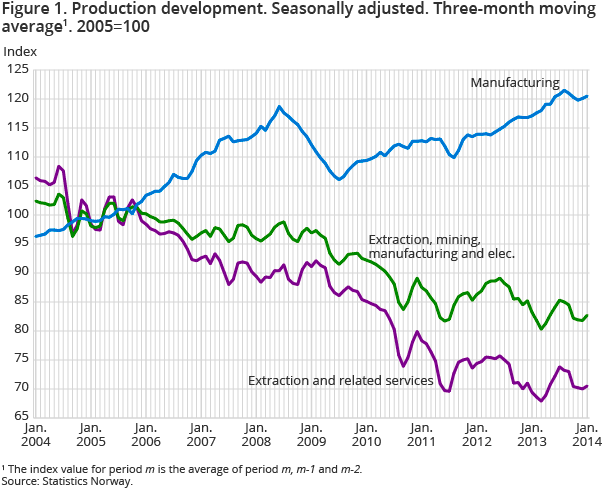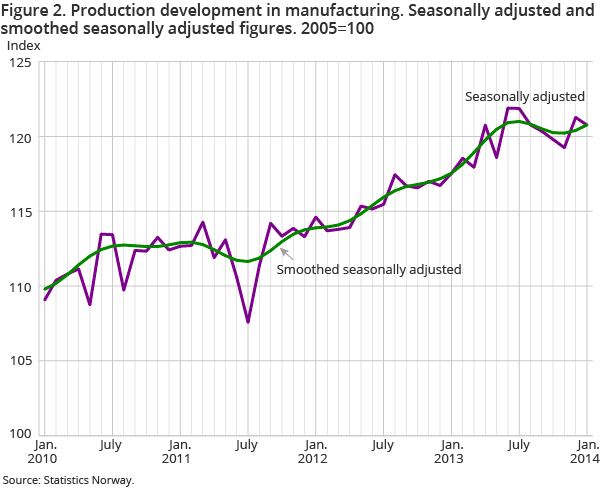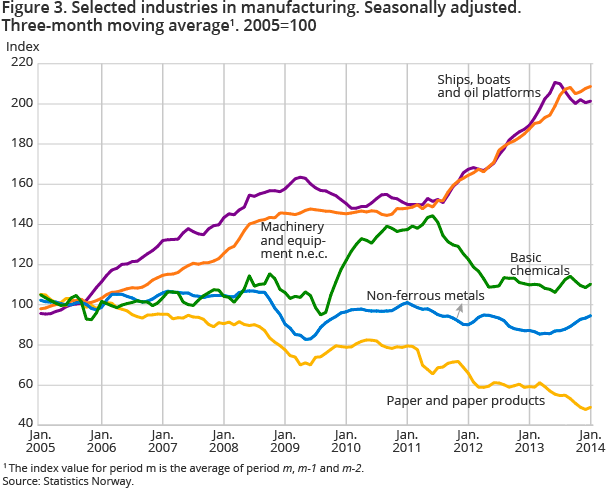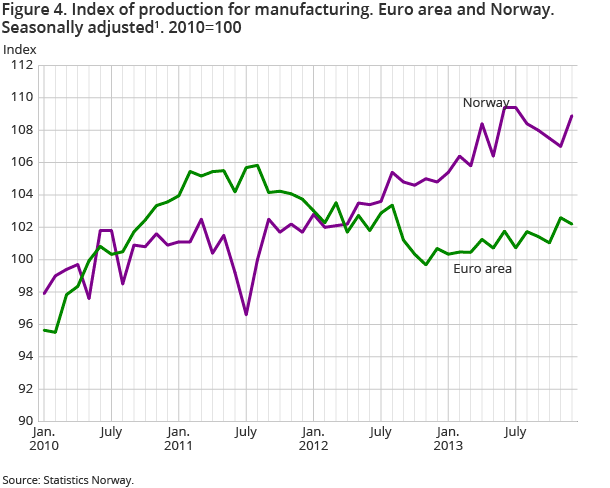Content
Published:
This is an archived release.
Minor changes in manufacturing
Production in Norwegian manufacturing increased by 0.2 per cent from November 2013 to January 2014 compared with the previous three-month period, according to seasonally-adjusted figures. On a month to month basis, from December 2013 to January 2014, the output in manufacturing went down by 0.4 per cent.
| Seasonally adjusted | Calendar adjusted1 | Weights2 | ||
|---|---|---|---|---|
| Monthly change | Three-month change | Twelve-month change | ||
| January 2014 / December 2013 | November 2013 - January 2014 / August 2013 - October 2013 | January 2014 / January 2013 | ||
| 1Adjusted for working-days and for public holidays in Norway. | ||||
| 2The weights are updated annually, and are valid for the entire year. | ||||
| Extraction, mining, manufacturing and elec | 1.1 | 0.6 | 2.5 | 100.0 |
| Extraction and related services | -0.7 | 0.1 | 1.7 | 71.9 |
| Mining and quarrying | -2.9 | -9.3 | -11.3 | 0.6 |
| Manufacturing | -0.4 | 0.2 | 2.7 | 22.7 |
| Food, beverage and tobacco | -0.7 | -3.0 | -3.3 | 4.1 |
| Refined petro., chemicals, pharmac. | 9.4 | -0.9 | 3.5 | 2.0 |
| Basic metals | -1.7 | 1.8 | -0.7 | 1.1 |
| Machinery and equipment | -0.6 | 1.8 | 9.1 | 3.2 |
| Ships, boats and oil plattforms | -2.5 | 0.6 | 3.8 | 2.4 |
| Electricity, gas and steam | 7.2 | 1.5 | -0.4 | 4.8 |




Production in non-ferrous metals increased by 4.0 per cent from November 2013 to January 2014 compared with the previous three-month period, according to seasonally-adjusted figures . Basic chemicals, on the other hand, had a minor decrease in production in the same period. In addition, there was also a decline of 1.8 per cent in food and food products from November 2013 to January 2014, compared with the previous three-month period. This was related to somewhat lower production of fish and fish products as well as feed and feed products.
Industries such as fabricated metal products, computer and electrical equipment together with machinery and equipment and ships, boats and oil platforms saw an increase in output from November 2013 to January 2014, compared with the previous three-month period.
Monthly change: downturn in manufacturing from December 2013 to January 2014
Production in food and food products decreased by 2.0 per cent from December 2013 to January 2014. In addition, ships, boats and oil platforms and repair and installation of machinery experienced a production downturn of 2.5 and 1.2 per cent respectively in the same period.
On the other hand, non-ferrous metals went up by 7.3 per cent from December 2013 to January 2014, according to seasonally-adjusted figures. Furthermore, basic chemicals also had an output increase equivalent to 4.9 per cent in the same period. These changes are related to improved international demand for industrial raw materials throughout 2013.
Twelve-month change: stronger growth in Norway than in the Euro area in January 2014
Production in Norwegian manufacturing went up by 3.8 per cent from December 2012 to December 2013, according to calendar-adjusted figures . Statistics from Eurostat show that production in the manufacturing industries in the euro area increased by 0.8 per cent in the same period.
Three-month change: minor increase in total industrial production (PII)
The overall production index (PII) covering extraction, mining, manufacturing and electricity supply increased by 0.6 per cent from November 2013 to January 2014 compared with the previous three-month period, according to seasonally-adjusted figures. Extraction of crude petroleum went up by 4.6 per cent, while extraction of natural gas decreased by 4.9 per cent in this period. On a month to month basis, from December 2013 to January 2014, extraction of crude petroleum and extraction of natural gas went down by 0.4 and 1.3 per cent respectively. There was reduced activity for several fields due to maintenance work in January 2014, according to The Norwegian Petroleum Directorate .
Production within Norwegian electricity supply increased by 1.5 per cent from November 2013 to January 2014 compared with the previous three-month period, according to seasonally-adjusted figures.
Updated weights in the PIIOpen and readClose
The weights in PII are updated by the transition to a new year. The basis for the weights in the index of industrial production (PII) is value added at factor prices from the annual structure statistics for oil and gas, manufacturing, electricity and district heating for 2012. The value added figures are updated to the situation at the end of 2013 with rates of change from the quarterly national account, and volume figures from the Norwegian Petroleum Directorate.
Industries such as fabricated metal products, machinery and equipment, ships, boats and oil platforms together with repair, installation of machinery were among the industries that had the largest increase in weights from 2013 to 2014. On the other hand, weights for basic chemical and non-ferrous metals had the largest drop.The weights for extraction and related services also declined, as a result of decreased weights for both crude petroleum and natural gas.
Updated productivity factors in the PIIOpen and readClose
As of January 2014, updated productivity factors will be included in the calculation of the production index (PII) covering extraction, mining, manufacturing and electricity supply. The factors are based on annual volume change in GDP per hour worked for the relevant industries and are an average from the last five years. This information is collected from the annual national account.
Contact
-
Production and turnover
E-mail: prodoms@ssb.no
